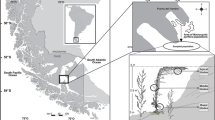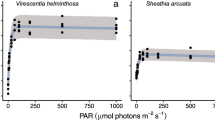Abstract
We compared the effect of habitat and water depth on the light-harvesting pigment content for Ascophyllum nodosum and Fucus vesiculosus at two near-shore stations in Long Island Sound (USA). Excised pieces of seaweeds were attached at depth intervals to a vertically buoyed line, and left in situ for 7 days. For comparison, fronds were collected from sun and shade habitats in the littoral zone. The three major antenna (light-harvesting) pigments increased in concentration with depth or shade. Chlorophyll c to a ratios remained stable at about 0.2. Fucoxanthin to chlorophyll a ratios decreased by 20 to 30% with depth or shade. Although pigment composition for the two rockweed species was equivalent, the maximum photosynthetic performance of F. vesiculosus exceeded that of A. nodosum by a factor of 2, while the compensation depths for 4 m-adapted A. nodosum and F. vesiculosus under natural limiting light conditions were equivalent. Plants held at 4 m had higher photosynthetic rates compared with plants held at 0 m, no matter the depth of measurement. Indirect evidence indicates that the enhanced photosynthesis of 4 m-adapted plants is due not only to higher concentrations of antenna pigments but to other physiological factors as well. We conclude that the clearly delineated vertical distribution of these two canopy species, the F. vesiculosus zone over the A. nodosum zone, is not determined by light quantity or quality, but by biotic factors as evidenced by the experiments of Menge which are cited herein.
Similar content being viewed by others
Literature Cited
Brinkhuis, B.H. and R.F. Jones: The ecology of temperature salt-marsh fucoids. II. In situ growth of transplanted Ascophyllum nodosum ecads. Mar. Biol. 34, 339–348 (1976)
—, N.R. Tempel and R.F. Jones: Photosynthesis and respiration of exposed salt-marsh fucoids Mar. Biol. 34, 349–359 (1976)
Conover, S.A.M.: Oceanography of Long Island Sound, 1952–1954. IV. Phytoplankton. Bull. Bingham oceanogr. Coll. 15, 62–112 (1956)
Crossett, R.N., E.A. Drew and A.W.D. Larkum: Chromatic adaptation in benthic marine algae. Nature, Lond. 207, 547–548 (1965)
Davies, B.H.: Analysis of carotenoid pigments. In: Chemistry and biochemistry of plant pigments, pp 489–532. Ed. by T.W. Goodwin. New York and London: Academic Press 1965
Jeffrey, S.W. and G.F. Humphrey: New spectrophotometric equations for determining chlorophylls a, b, c 1and c 2in higher plants, algae and natural phytoplankton. Biochem. Physiol. Pfl. 167, 191–194 (1975)
Jensen, A.: Carotenoids of Norwegian brown seaweeds and of seaweed meals. Rep. Norw. Inst. Seaweed Res. 31, 1–138 (1966)
Jerlov, N.G.: Optical oceanography, 194 pp. New York: Elsevier Publishing Co. 1968
Kanwisher, J.: Photosynthesis and respiration in some seaweeds. In: Some contemporary studies in marine sciences, pp 407–420. Ed. by H. Barnes. London: George Allen & Unwin Ltd. 1966
King, R.J. and W. Schramm: Determination of photosynthetic rates for the marine algae Fucus vesiculosus and Laminaria digitata. Mar. Biol. 37, 209–213 (1976)
Krinsky, N.I.: The protective function of carotenoid pigments. In: Photophysiology, Vol. III. pp 123–195. Ed. by A.C. Giese. Academic Press: London and New York 1968
Menge, J.L.: Effect of herbivores on community structure of the New England rocky intertidal region: distribution, abundance and diversity of algae, 164 pp. Ph.D. dissertation, Harvard University, Cambridge, Mass. 1975
Ramus, J., S.I. Beale and D. Mauzerall: Correlation of changes in pigment content with photosynthetic capacity of seaweeds as a function of water depth. Mar. Biol. 37, 231–238 (1976a)
——— and K.L. Howard: Changes in photosynthetic pigment concentration in seaweeds as a function of water depth. Mar. Biol. 37, 223–229 (1976b)
Wassman, E.R. and J. Ramus: Primary-production measurements for the green seaweed Codium fragile in Long Island Sound. Mar. Biol. 21, 289–297 (1973)
Zelawski, W. and R.B. Walker: Photosynthesis, respiration, and dry matter production. In: Modern methods in forest genetics, pp 89–119. Ed. by J.P. Miksche. Berlin: Springer-Verlag 1976
Author information
Authors and Affiliations
Additional information
Communicated by M.R. Tripp, Newark
Rights and permissions
About this article
Cite this article
Ramus, J., Lemons, F. & Zimmerman, C. Adaptation of light-harvesting pigments to downwelling light and the consequent photosynthetic performance of the eulittoral rockweeds Ascophyllum nodosum and Fucus vesiculosus . Mar. Biol. 42, 293–303 (1977). https://doi.org/10.1007/BF00402191
Accepted:
Issue Date:
DOI: https://doi.org/10.1007/BF00402191




